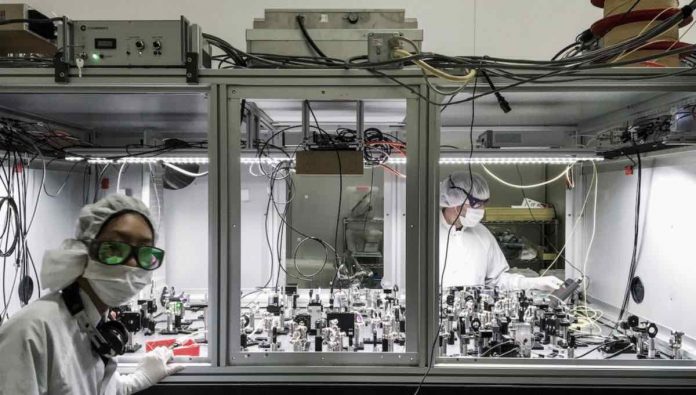Observations showed that 88-pound mirrors were ‘kicked’ by the ‘spooky popcorn of the universe.’
Quantum physics is the realm of tiny particles no longer. Scientists at the giant gravitational wave detector LIGO in the US are now measuring the quantum effects of 40-kilogram mirrors used to detect gravitational waves.
While physicists routinely observe quantum effects in nanometre-scale experiments, LIGO team member Robert Ward says this new level of sensitivity was unmatched in other experiments.
“There’s nowhere else close, nothing like it. That’s as big as my kids!” says Ward, who is part of the OzGrav Research Centre based at the Australian National University (ANU).
“The reality that we can measure to this level of precision on an instrument that is so large is incredible,” adds his ANU colleague Terry McRae, who recently spent a year installing new componentry at the Livingston site in Louisiana, US.
Livingston is one of two linked gravitational wave detectors run by the LIGO organisation. Each detector is made of two high-powered laser beams at right angles, bouncing between mirrors four kilometres apart. The second is in Washington State, 3000 kilometres to the northwest.
The LIGO team has published results in the journal Nature that accurately show quantum correlations between the 40-kilogram mirrors and the laser beam, which at 200 kilowatts is about 2000 times more powerful than a laser cutter.
For the purpose of detecting gravitational waves, it has used the correlations and manipulated the quantum properties of the system, to reduce noise and make it more sensitive, a technique called quantum squeezing.
The sensitivity of LIGO is crucial. Although black hole collisions are the most violent events known to humans, the gravitational waves from them reach earth as tiny flickers in space and time. In the triumphant first detections of gravitational waves, LIGO’s mirrors moved about a billionth of the diameter of the atoms making up the mirrors,
The two-decade story of LIGO is one of tirelessly removing one noise source after another, says ANU’s Nutsinee Kijbunchoo.
“We’re always trying to do better: sensitivity less than the width of a hair? Not good enough, we have to keep improving,” she says.
Kijbunchoo worked with McRae on the recent upgrade at Livingston and was amazed to see people banging on parts of the apparatus to try to induce noise, characterise it precisely and work out how to cut it out.
A recent paper announced the new sensitivity levels reached, thanks to the new quantum squeezing system that Kijbunchoo and McRae were involved in installing. The paper estimated that the improvement would lead to a 50% jump in the rate of gravitational wave detections.
This new paper takes a step back, however, and discusses the significance of the LIGO’s sensitivity, saying in its conclusions that “the measurements presented here represent long-awaited milestones in verifying the role of quantum mechanics in limiting the measurement of small displacements…”.
Rob Ward says this moment has been a long time coming, citing Russian scientist Braginsky as one of the first to begin thinking about the quantum limits of measurement in 1996.
“Now we’ve crossed that threshold, and now we have to start thinking about the quantum mechanics of our test masses (mirrors). We’re being forced to grapple with the quantum mechanics of a human-sized objects,” Ward says.
The quantum noise has been revealed after an intricate system of suspension wires, feedback systems, laser stabiliser and cooling systems have stabilised the experiment – removing the so-called classical noise.
You would think all of these vibrations and wobbles could be cut out completely, but quantum noise is a fundamental property of a system, first expressed by Heisenberg in the famous Uncertainty Principle, which lays out that measurements have limits to their precision, beyond which you cannot pass, no matter how cold, stable or isolated your experiment is.
But there is a loophole: these measurements come in pairs, and the uncertainty is distributed between the pairs, and can be shifted from one quantity to the other.
Imagine cleaning the house, which you could measure by how fast it was done, or how clean the house ends up. The quicker the clean-up, the lower the final standard of cleanliness. Or, an exhaustive spring clean could take well past tea time.
It’s this kind of trade-off that the squeezing system uses – in this case playing off the radiation pressure against the randomness in the arrival time of the photons. The trick is the photons need to be paired – correlated – which enables the quantum link to be leveraged.
These play into the overall noise differently for different signals, so the LIGO scientists constrain the value of one that will make the experiment most sensitive, say to a neutron star merger, and let the other be a little less certain.
This is how the LIGO detector achieves sensitivity that is better than non-quantum physics could have imagined – a limit known as the standard quantum limit (SQL).
These quantum tricks can only be used if the overall noise is infinitesimal, otherwise the pairings become smeared out, and quantum effects can’t be seen.
This is the case in our everyday world. But now, says Ward, with this exquisite instrument we’re in a realm we’ve never seen before.
“We never normally see quantum effects of big objects, and we don’t exactly know why, but now we’re getting to that level of precision,” he says. “We’re exploring fundamental questions about reality.”





























